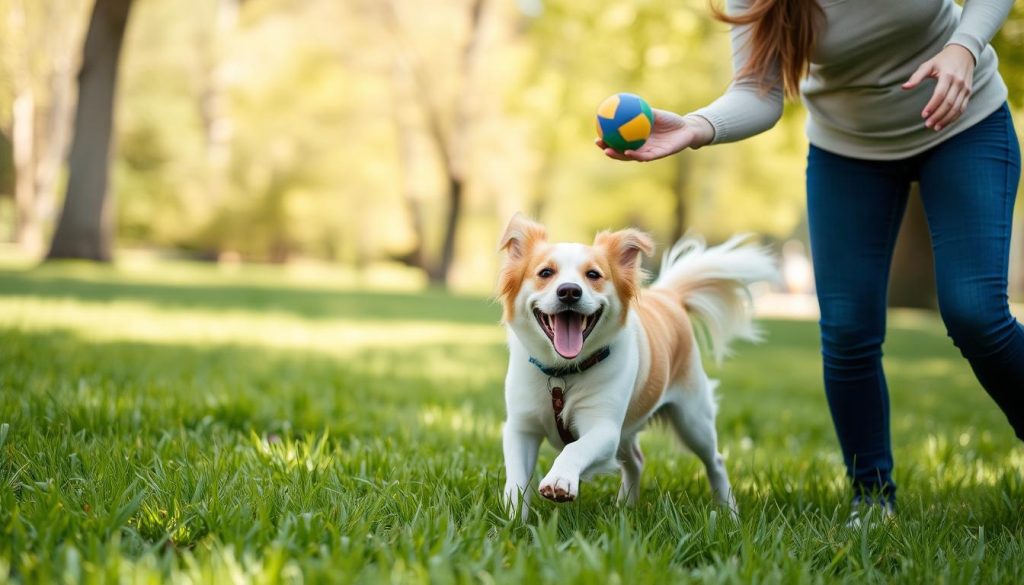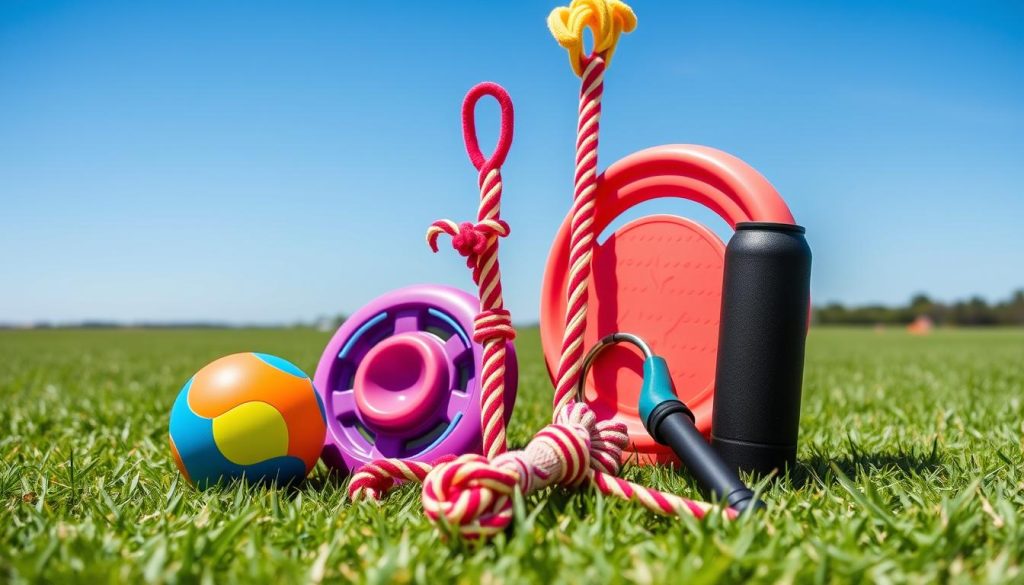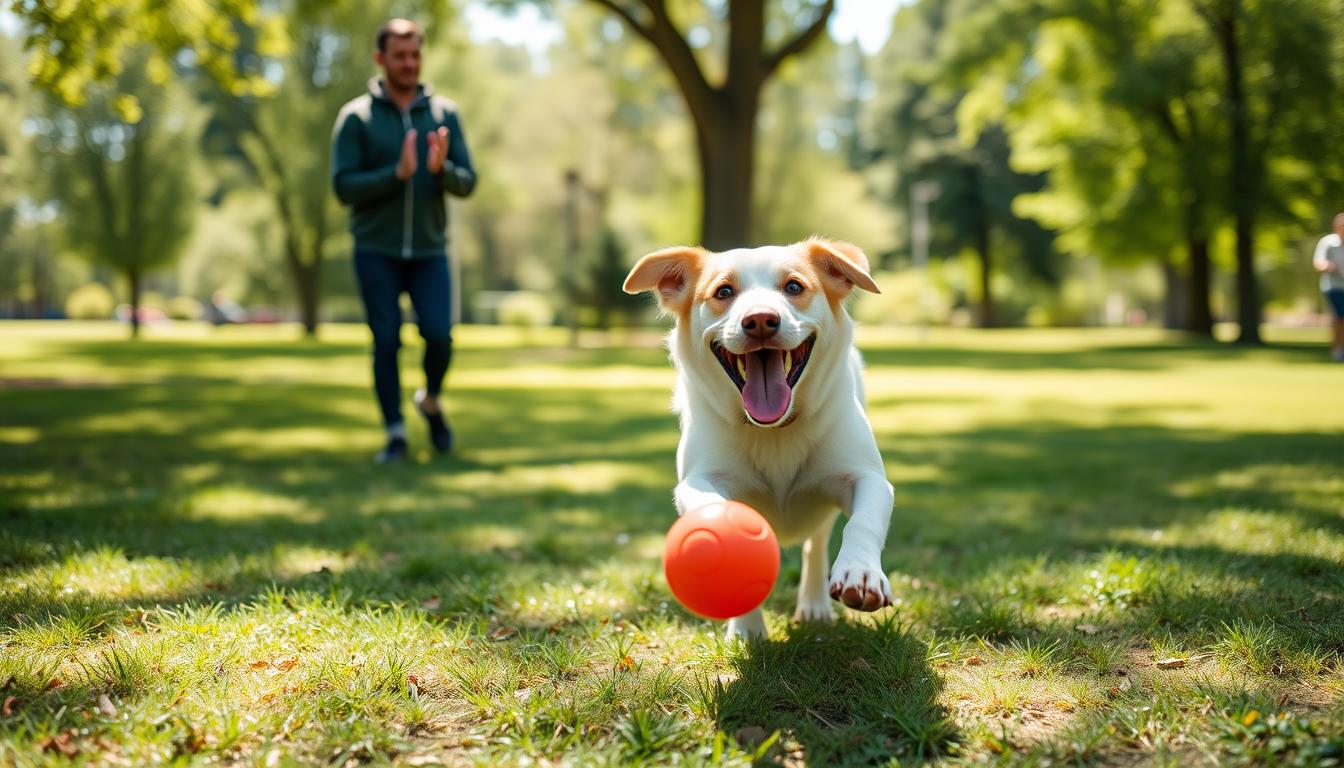Have you ever watched a dog pick up a ball or toy with ease? You might wish your dog could do the same. But, with the right training, you can make your dog a fetch pro. So, what makes the fetch command so important for a dog’s development?
In this guide, we’ll show you how to teach your dog to fetch and return. You’ll learn why this skill is crucial and how to train your dog step by step. Get ready to turn your dog into a fetch and return expert. Let’s start and strengthen your bond with your dog.
Understanding the Importance of the Fetch Command
The fetch command is more than just a fun game for your dog. It’s a key training tool that can make your bond stronger. It also gives your dog physical and mental stimulation.
Teaching your dog to fetch and return is a great way to improve your relationship. This activity lets you spend quality time with your dog. It builds trust and makes your dog want to please you more.
Fetch is also great for keeping your dog’s mind and body active. It challenges their natural instincts and prevents boredom. Plus, it helps keep your dog fit and healthy.

Quick Recommendation : Our blog is filled with tips , tricks, and methods for training your dog. If you would like to attend a Free Dog Training Workshop, we recommend the K9 Training Institute.
Adding fetch to your dog’s training is a smart move. It teaches them a valuable skill and strengthens your bond. This command is flexible and can be adjusted for any dog’s needs. It’s a fun way to enrich your dog’s life and yours too.
Preparing for Training: Essential Supplies and Environment
Starting your dog’s fetch training needs careful planning. First, collect the fetch training supplies like durable toys and treats. Pick a dog-friendly training area with no distractions and enough room for your dog to play.
It’s key to have a distractions-free space for training. Look for a quiet, enclosed spot away from noise or other pets. This keeps your dog focused during rewarding fetch training.

Quick Recommendation : Our blog is filled with tips , tricks, and methods for training your dog. If you would like to attend a Free Dog Training Workshop, we recommend the K9 Training Institute.
When setting up the training area, think about the surface. A soft grassy spot or a padded room is best for your dog’s comfort. Make sure there are no hazards or obstacles to get in the way.
With the right supplies and setup, you’re ready for a fun and successful fetch training journey. It will be great for both you and your dog.
Step-by-Step Guide to Teaching Your Dog to Fetch
Teach your dog to fetch and watch them become a sports star. Start with simple steps and lots of praise. Begin by saying “fetch” and giving treats when they listen. Then, make the game longer and harder.
Patience and consistency are key. Break it down into easy steps and celebrate each win. Use treats, praise, and favorite toys to make them want to play.
With time and positive feedback, your dog will learn to fetch. Keep training fun and short. Never push them to do something they don’t want to. This way, you’ll build a strong bond and master fetch together.
Advancing to the Return Phase of the Fetch Command
Now that your dog knows the fetch command basics, it’s time to work on the return phase. This part is key to making your dog a reliable fetch and return partner. With patience and practice, you can help your dog become more skilled.
The return phase teaches your dog to bring the object back to you. Start by rewarding them when they begin to return, even if they don’t finish. As they get better, increase the distance and time they need to return. This will boost their confidence and make them want to complete the fetch and return.
Being consistent is important in teaching the return phase. Practice the fetch and return in short, regular sessions. Use fun objects and make training enjoyable. As your dog gets better, you can add new challenges, like returning to a specific spot or around obstacles.
Every dog learns at their own speed, so be patient and celebrate small wins. With time and effort, you’ll have a dog that fetches and returns smoothly. This will make playtime even more fun for both of you.
Troubleshooting Common Challenges
Every fetch training journey has its ups and downs. But with the right strategies, you can tackle any problem. One big challenge is distractions during fetch training. To avoid distractions, pick a quiet spot with few outside noises. As your dog gets better, you can add more distractions.
Another issue is when your dog doesn’t want to fetch. To keep them interested, try different toys and treats. Some dogs love squeaky toys, while others prefer tennis balls or treats. Stay patient and make the training fun.
Some dogs find the return phase of the fetch command hard. Try adding the “come” command to your training. Reward your dog for bringing the toy back. Gradually make the fetch-and-return routine more challenging to build their confidence.
By tackling these common fetch training problems directly, you can help your dog become a fetch pro. Be patient, try different methods, and always keep the training positive and rewarding for your dog.
Quick Recommendation : Our blog is filled with tips , tricks, and methods for training your dog. If you would like to attend a Free Dog Training Workshop, we recommend the K9 Training Institute.
Teaching Your Dog to Fetch and Return
Teaching your dog to fetch and return is a big goal for dog owners. Start with basic training steps to make your dog a fetch expert. Then, keep up the training to keep their interest high.
Begin with short, frequent practice sessions. Give lots of rewards when they bring the toy back. This makes them want to play more.
When they get better, make the game harder. Throw the toy in different places or behind things. Keep practicing every day to keep their skills sharp.
Positive reinforcement is key to teaching fetch. Praise and treat them for every success. With patience, your dog will love playing fetch.
Incorporating Fetch into Daily Playtime
Fetch is more than just a training exercise. It’s a fun and engaging daily activity that strengthens your bond with your furry friend. By adding fetch to your regular playtime, you keep the game exciting. It also enriches your dog’s exercise routine and deepens your connection through this classic canine pastime.
Make fetch a part of your daily routine by setting aside dedicated fetch time. Whether it’s a quick game in the backyard or a longer session at the park, this special time shows fetch is a priority. It becomes a cherished part of your day, offering a chance to bond while keeping your dog physically and mentally stimulated.
To keep fetch playtime enriching and enjoyable, mix up the game. Use different toys, change the distance, or introduce new commands. This keeps the game exciting and prevents boredom. Praise and rewards during the game also strengthen your bond with your canine companion.
Embracing fetch as a daily exercise and playtime activity is great for your relationship with your dog. It keeps your pup physically fit and deepens your bond through this shared activity. Fetch is truly a win-win for both you and your furry friend!
Safety Considerations During Fetch Training
When teaching your dog to fetch, their safety is key. Safe fetch training keeps your dog safe and makes playtime fun for both of you. Knowing the risks and taking steps to avoid them helps prevent injuries and keeps your dog healthy.
Choosing the right object to throw is crucial. Stay away from sticks or rocks that could hurt your dog. Use durable, safe toys made for fetch games. These toys won’t break or harm your dog if they run into them.
It’s also important to manage your dog’s excitement. It’s great to see them chase after the toy, but watch their behavior. Give them breaks, make sure they have water, and play on safe surfaces. Hard or uneven areas can lead to injuries.
By focusing on safety in fetch training, you create a fun and healthy playtime for your dog. Always put your dog’s well-being first when playing fetch.
Conclusion
Let’s wrap up our guide on teaching your dog to fetch and return. Mastering this command brings joy to both you and your dog. It also makes your bond stronger.
You’ve learned how crucial the fetch command is. You know what supplies and environment are needed for training. You’ve also found out how to teach your dog this classic game step by step.
Learning to advance to the return phase and solving common problems was covered. You’ve seen how to make fetch a part of your daily playtime.
Using these tips, you’ll have a well-trained dog and enjoy many benefits. This skill keeps your dog’s mind and body active. It also shows your dog who’s in charge, deepening your connection.
Remember, practice and positive feedback are key. They help make this command a strong part of your dog’s training.
Quick Recommendation : Our blog is filled with tips , tricks, and methods for training your dog. If you would like to attend a Free Dog Training Workshop, we recommend the K9 Training Institute.

